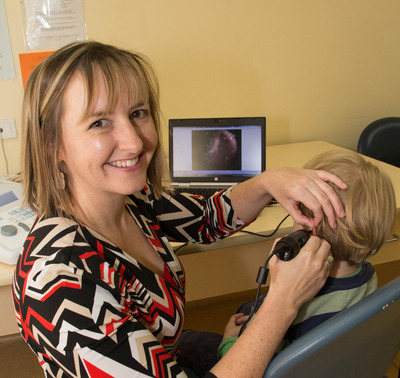Glue ear mystery comes unstuck
Research from the University of Western Australia (UWA) could have a significant impact on the treatment of ear infections, reducing the need for antibiotics and surgery and tackling hearing loss in Indigenous communities.
Dr Ruth Thornton and the UWA team discovered that sticky nets of DNA hide bacteria in the ears of kids with recurrent middle ear infections, where they evade antibiotic treatment by creating impenetrable slimy biofilms. Dr Thornton explained that these nets are made from the children’s own immune systems.
“It is similar to what happens in the lungs of people with cystic fibrosis, where a treatment known as dornase alfa is used to break this sticky DNA up,” she said. The researchers are now trialling this treatment in children’s ears.


Middle ear infection, or otitis media, is one of the most common childhood complaints. It occurs in the space behind the eardrum where fluid collects and bacteria can cause painful infections. For some children, this fluid doesn’t go away, becoming like egg white over time and leading to ‘glue ear’.
Some children strike it extra unlucky with chronic infections that resist antibiotics and require the insertion of ventilation tubes called grommets into their eardrums. Re-infection leads to repeat surgery in 30% of these children, and the condition’s chronic nature has been associated with hearing loss and learning difficulties.
The clinical trials at UWA involve 60 children under the age of five, who will each receive dornase alfa in one ear during grommet surgery. The other ear will be used as a comparison and receive only surgery. Results will be collected over two years, with a larger national trial planned after this one is completed.
There are also plans to trial the treatment in Indigenous children, who suffer from high rates of severe chronic middle ear infections, which can cause extensive hearing loss and chronically running ears.
“This is the first potential change in treating middle ear infections for a long time, and more effective treatments will hopefully lead to improved hearing, better learning outcomes and a reduced burden on children and their families,” Dr Thornton said.
Dr Thornton is one of 12 national finalists - and the only one from WA - in the annual Fresh Science competition, a national program sponsored by the Australian Government through the Inspiring Australia initiative.
Her study was published in the online science journal PLOS ONE in February.
Biomarkers for SIDS found in blood samples
US researchers have revealed the fingerprints of sudden infant death syndrome (SIDS) within blood...
Uncurling and 'gluing down' DNA molecules for sharper imaging
Researchers at Nagoya University have demonstrated techniques for stretching and immobilising DNA...
Novel 3D bioprinter can replicate human tissue
Biomedical engineers have invented a 3D printing system capable of fabricating structures that...




